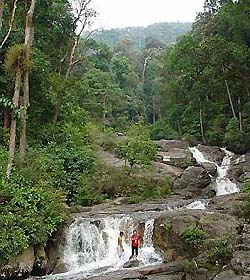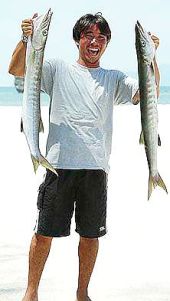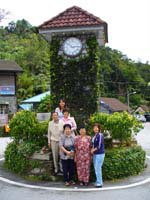The lure of the Puteri’s mountain
By Meera Viajayan
Saturday August 12, 2006
Mountain climbing may sound like a sport for extreme adventure enthusiasts, but 56-year-old Singaporean Hoong Ah Sin who has climbed up Gunung Ledang more than 100 times will tell you otherwise.
“Anyone can climb a mountain. You just have to go up like an ant,” said the youthful looking Hoong who has climbed up Gunung Ledang 115 times and also conquered Gunung Tahan twice.

“An aspiring mountaineer just has to control and suffer during the first 30 minutes of the climb. If he can keep going for the initial half an hour at a steady pace, he should be able to last for hours after that,” he said.
According to Hoong who takes groups of Singaporean tourists up Gunung Ledang, many of them did not have any experience in mountain climbing.
“Don’t stop for long rests and don’t sit down too often. The maximum you should stop is about three to five minutes at a time,” he said adding that despite taking many mountain novices up, he has not had any complaints from them.
Lest one should imagine that the climb up Gunung Ledang or Mt Ophir is a breeze, the mountain has been rated the sixth toughest mountain to climb in Malaysia, with Sabah’s Gunung Kinabalu trailing far behind as the12th hardest, by Gunung Ledang resort managing director Tey Chee Yan.
At 1,276m above sea level, Gunung Ledang registers some 20,000 climbs a year with more than a million visitors annually.

“Many come here to enjoy the waterfall and have a leisurely picnic with their families and friends,” he said.
According to Tey, a favourite spot for picnickers was the Princess Waterfalls, about a 45-minute trek from the base of the mountain.
For city slickers who balk at the thought of an almost hour long walk, rest assured that the jungle trekking route to the waterfalls is manageable with clearly marked trails and often paved steps.

The trail is also pleasant as the shade from the leafy canopy provides a welcome respite from the tropical heat with small gazebos along the way giving tired climbers a chance to rest.
Climbers may also choose to stop at any of the many naturally formed bathing pools shielded by large boulders along the way, but the trek to the Puteri Waterfalls is well worth the effort for a cool and refreshing dip under the rushing waterfall.
The mountain is also richly steeped in history and mystery with its most famous legend being that of Puteri Gunung Ledang, a princess of the Maja-pahit empire who was once wooed by one of the Sultans of Malacca.
A legend goes that the princess insisted she would marry the Sultan only if he built a golden bridge and a silver bridge linking her mountain to his palace, sent her seven trays of mosquito hearts, seven jars of virgin’s tears as well as a bowl containing the blood of the Sultan’s son.
Whether one believes in the superstition that the spirit of the princess roams the mountain to this day or not, a chance to enjoy the waterfalls and get away from the bustle of city life is reason enough to enjoy the experience with nature.
For enquiries, please contact the Gunung Ledang Resort at +60 6 977 2888 or visit www.ledang.com for more details.
More info about mountains in Malaysia:
Mount Kinabalu Sabah Borneo Malaysia, an outdoor adventure travel
Travel the mystic mountains of Malaysia
Gunung Brinchang Cameron Highlands adventure travel by car
By Meera Viajayan
Saturday August 12, 2006
Mountain climbing may sound like a sport for extreme adventure enthusiasts, but 56-year-old Singaporean Hoong Ah Sin who has climbed up Gunung Ledang more than 100 times will tell you otherwise.
“Anyone can climb a mountain. You just have to go up like an ant,” said the youthful looking Hoong who has climbed up Gunung Ledang 115 times and also conquered Gunung Tahan twice.

One of the smaller streams from the cascading waterfall.
“An aspiring mountaineer just has to control and suffer during the first 30 minutes of the climb. If he can keep going for the initial half an hour at a steady pace, he should be able to last for hours after that,” he said.
According to Hoong who takes groups of Singaporean tourists up Gunung Ledang, many of them did not have any experience in mountain climbing.
“Don’t stop for long rests and don’t sit down too often. The maximum you should stop is about three to five minutes at a time,” he said adding that despite taking many mountain novices up, he has not had any complaints from them.
Lest one should imagine that the climb up Gunung Ledang or Mt Ophir is a breeze, the mountain has been rated the sixth toughest mountain to climb in Malaysia, with Sabah’s Gunung Kinabalu trailing far behind as the12th hardest, by Gunung Ledang resort managing director Tey Chee Yan.
At 1,276m above sea level, Gunung Ledang registers some 20,000 climbs a year with more than a million visitors annually.

Standing at 1,276m above sea level, Gunung Ledang registers some 20,000 climbs a year with more than a million visitors annually.
Tey revealed that not all visitors to the mountain were interested in scaling the peaks.
Tey revealed that not all visitors to the mountain were interested in scaling the peaks.
“Many come here to enjoy the waterfall and have a leisurely picnic with their families and friends,” he said.
According to Tey, a favourite spot for picnickers was the Princess Waterfalls, about a 45-minute trek from the base of the mountain.
For city slickers who balk at the thought of an almost hour long walk, rest assured that the jungle trekking route to the waterfalls is manageable with clearly marked trails and often paved steps.

The route to the waterfall is manageable with clearly marked trails.
The trail is also pleasant as the shade from the leafy canopy provides a welcome respite from the tropical heat with small gazebos along the way giving tired climbers a chance to rest.
Climbers may also choose to stop at any of the many naturally formed bathing pools shielded by large boulders along the way, but the trek to the Puteri Waterfalls is well worth the effort for a cool and refreshing dip under the rushing waterfall.
The mountain is also richly steeped in history and mystery with its most famous legend being that of Puteri Gunung Ledang, a princess of the Maja-pahit empire who was once wooed by one of the Sultans of Malacca.
A legend goes that the princess insisted she would marry the Sultan only if he built a golden bridge and a silver bridge linking her mountain to his palace, sent her seven trays of mosquito hearts, seven jars of virgin’s tears as well as a bowl containing the blood of the Sultan’s son.
Whether one believes in the superstition that the spirit of the princess roams the mountain to this day or not, a chance to enjoy the waterfalls and get away from the bustle of city life is reason enough to enjoy the experience with nature.
For enquiries, please contact the Gunung Ledang Resort at +60 6 977 2888 or visit www.ledang.com for more details.
































